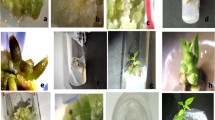Abstract
The influence of plant growth regulators, sucrose, calcium and various macronutrient media on callus friability and somatic embryogenesis was investigated inHevea brasiliensis Müll. Arg. Friable and embryogenic calli were spontaneously formed in two rubber tree clones (PR 107 and RRIM 600) on the Medium for Hevea (MH), with 3,4-dichlorophenoxyacetic acid (3,4-d), kinetin and sucrose, while compact embryogenic calli were enhanced in three other clones (PB 260, PB 235 and GT1). Callus friability was enhanced in clone PB 260 when the concentration of one growth factor (3,4-d or kinetin) was reduced from 4.5 μLM to 0.45 μM during the first culture, or when high sucrose or calcium levels 351 mM and 12 mM, respectively) were maintained during subcultures. The different macronutrient media did not alter callus texture but only use of MH and Murashige and Skoog (MS) media led to somatic embryogenesis. Friable calli obtained by modifying the auxin/cytokinin balance lost their embryogenic potential. In contrast, those obtained on media with high sucrose or calcium concentrations were mainly composed of embryogenic cells embedded in a mucilaginous matrix. Such calli could be of potential interest for establishing embryogenic cell suspension cultures.
Similar content being viewed by others
Abbreviations
- BC:
-
brown calli
- 3,4-d :
-
3,4-dichlorophenoxyacetic acid
- EA:
-
embryogenic activity
- EC:
-
callus bearing embryos
- FC:
-
friable calli
- FEC:
-
friable callus bearing embryos
- MA:
-
meristematic activity
- MH:
-
Medium for Hevea
- Muc:
-
mucilage
- OP:
-
oxidized polyphenols
References
Armstrong CL & Green CE (1985) Establishment and maintenance of friable, embryogenic maize callus and the involvement ofl-proline. Planta 164: 207–214
Bregitzer P, Somers DA & Rines HW (1989) Development and characterization of friable, embryogenic oat callus. Crop Science 29: 798–803
Carrier DJ, Cosentino G, Neufeld R, Rho D, Weber M & Archambault J (1990) Nutritional and hormonal requirements ofGinkgo biloba embryo-derived callus and suspension cell culture. Plant Cell Rep. 8: 635–638
Carron MP, Enjalric F, Lardet L & Deschamps A (1989) Rubber (Hevea brasiliensis Müll. Arg.). In: Bajaj YPS (Ed) Biotechnology in Agriculture and Forestry, Vol 5 Trees II (pp 222–245). Springer-Verlag, Berlin
Carron MP, d'Auzac J, Etienne H, El Hadrami I, Housti F, Michaux-Ferrière N & Montoro P (1992) Biochemical and histological features of somatic embryogenesis on rubber (Hevea brasiliensis Müll. Arg.). Indian J. Nat. Rubb. Res. (in press)
Etienne H, Montoro P & Carron MP (1991) Incidence des paramètres hydriques sur le développement des cals d'Hevea brasiliensis en culturein vitro. Ann. Sci. For. 48: 253–265
Goodman LA (1965) On simultaneous confidence intervals for multinomial proportions. Technometrics 7: 247–254
Gray DJ & Mortensen JA (1987) Initiation and maintenance of long term somatic embryogenesis from anthers and ovaries ofVitis longii Microsperma. Plant Cell Tiss. Org. Cult. 9: 73–80
Lazzeri PA, Hildebrand DF & Collins GB (1987) Soybean somatic embryogenesis: Effects of hormones and culture manipulations. Plant Cell Tiss. Org. Cult. 10: 197–208
Micaux-Ferrière N, Grout H & Carron MP (1992) Origin and ontogenesis of embryos inHevea brasiliensis (Euphorbiaceae). Am. J. Bot. 79: 174–180
Muller AJ & Grate R (1978) Isolation and characterization of cell lines ofNicotiana tabacum lacking nitrate reductase. Molec. Gen. Genet. 161: 67–76
Noriega C & Söndahl MR (1991) Somatic embryogenesis in hybrid Tea Roses. Biotechnology 9: 991–993
Toriyamma K, Himaka K & Sasaki T (1986) Haploid and diploid regeneration from protoplasts of anther callus in rice. Theor. Appl. Genet. 73: 16–19
Vain P, Yean H & Flament P (1989) Enhancement of production and regeneration of embryogenic type 11 callus inZea mays L. by AgNO3. Plant Cell Tiss. Org. Cult. 18: 143–151
Vasil V & Vasil IK (1986) Plant regeneration from friable embryogenic callus and cell suspension cultures ofZea mays L. J. Plant Physiol. 124: 399–408
Wilson HM, Eisa MZ & Irwin SWB (1976) The effects of agitated medium onin vitro cultures ofHevea brasiliensis. Physiol. Plant. 36: 399–402
Yoshida F & Watanabe H (1971) Effects of mineral nutrients on chlorophyll contents, friability and yield of cultured Tobacco callus. Bull. Fac. Agric. 11: 3–14
Author information
Authors and Affiliations
Rights and permissions
About this article
Cite this article
Montoro, P., Etienne, H., Michaux-Ferrière, N. et al. Callus friability and somatic embryogenesis inHevea brasiliensis . Plant Cell Tiss Organ Cult 33, 331–338 (1993). https://doi.org/10.1007/BF02319019
Received:
Accepted:
Issue Date:
DOI: https://doi.org/10.1007/BF02319019




